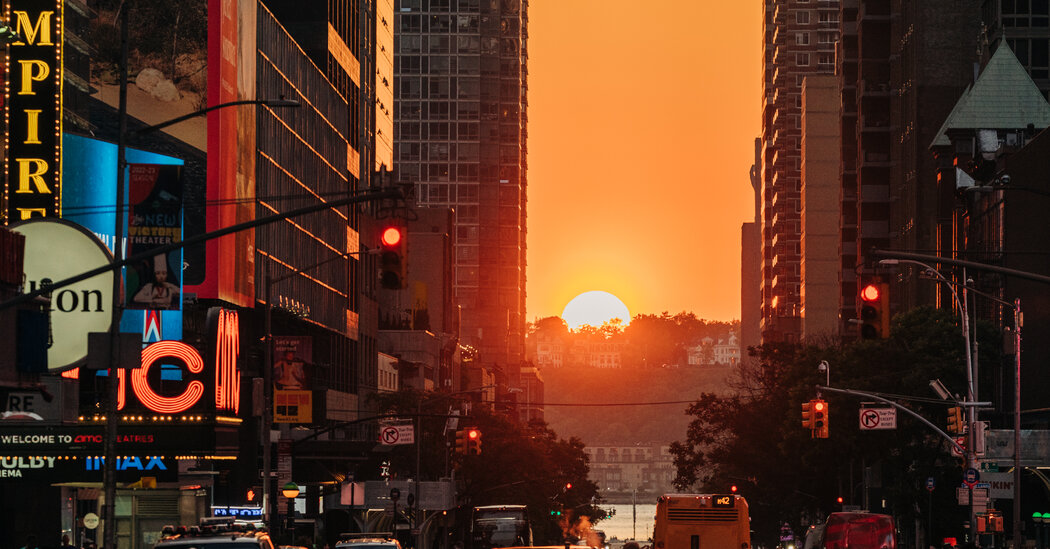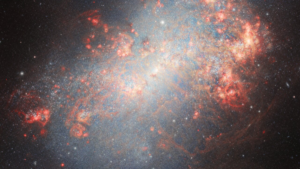New Yorkers, get ready for the latest solar spectacle.
Every year in late May and again in mid-July, residents and tourists flood the streets of Manhattan for a spectacular view of the sun setting in the west, framed by the city’s famous streetscapes. Dubbed Manhattanhenge, the event draws more people each year, some in crowds so dense they block streets.
“I think of it as in-your-face astronomy,” said Jackie Faherty, an astronomer at the American Museum of Natural History who calculates the dates for Manhattanhenge each year. “It’s like a huge science party that’s going to happen in town.”
The popularity of the event probably outweighs the interest in science, Dr. Faherty added: People love a good photo, and Manhattanhenge delivers.
When is Manhattanhenge?
This year, Manhattanhenge takes place on Tuesday, May 28 and Wednesday, May 29, then again on July 12 and 13.
According to the American Museum of Natural History, the sun will set at 8:13 PM on Tuesday and 8:12 PM on Wednesday local time. In July, the sun will set at 20:21 on the 12th and at 20:20 on the 13th.
The sunset will look different on consecutive days. On May 28, the upper half of the sun will line up with the city grid, but the next day the full sun will be visible. Later in the summer, this pattern reverses: viewers will see a full sun on July 12 and the upper half of the sun on July 13.
Will the clouds bother you?
Of the two options this week, Manhattanhenge on Tuesday looks like your best bet for a clear view of the setting sun.
Mostly clear skies are expected at 8 p.m. Tuesday in New York, according to a National Weather Service forecast issued Monday morning. The forecast also predicts clouds will cover about three-quarters of the sky at the same time on Wednesday.
Why should I see it?
Like April’s solar eclipse and the dancing aurora borealis, Manhattanhenge is another example of our home star bringing people together.
Sunsets are one of the easiest ways to embrace “the wonder of the cosmos,” Dr. Faherty said, adding that each one is different. “You never know how the light will look or feel as it sets, or what the atmosphere will be like around you.”
Longer days, warmer weather and the New York school year ending make Manhattanhenge “that much higher,” she said. “The whole thing is just a nice, relaxing summer party and celebration of astronomy.”
Why is Manhattanhenge happening?
The sun setting perfectly between the city canyons of New York is a result of the geometry of the sun and the Earth.
The sun sets in a different place each day because the Earth is tilted on its axis as it orbits the sun, Dr. Faherty said. In the spring, she explained, if you watch the sun looking west from the same spot, you’ll notice that where it sets moves a little north of the horizon each day.
After the summer solstice, which occurs on June 20 this year, the sun begins to move back south. “Ping-pong between the solstices,” said Dr. Faherty. “And that’s because we’re going around the sun like we’re doing loops around a track.”
That’s why there are two chances to see Manhattanhenge, in May and in July; the dates appear on either side of the summer solstice. Between these dates, viewers can still catch the sun rising from behind the city’s skyscrapers as it sets, although it will appear at different heights in the sky.
It’s a season of “epic sunsets in New York,” Dr. Faherty said.
How did Manhattanhenge begin?
In the 1800s, city planners designed New York as a grid: its boulevards run roughly north to south, and its cross streets are set at a 90-degree angle, running roughly east to west.
For as long as this grid has existed, people have likely noticed the phenomenon, Dr. Faherty said.
The earliest mention of this effect that Dr. Faherty has been able to track down is a 1997 comic strip published in the journal Natural History. Neil deGrasse Tyson, director of the Hayden Planetarium, coined the name “Manhattanhenge” in 2002, inspired by the ancient Stonehenge monument in England.
Since then, the excitement surrounding the event has grown every year. “People caught on and it caught on like wildfire,” Dr Faherty said.
Where can I see Manhattanhenge?
Among the most popular places to view this special sunset is the Tudor City Overpass, a pedestrian walkway over 42nd Street. The viewpoint offers a good view of the Chrysler Building.
Another favorite spot for photographers is the Park Avenue Viaduct a few boulevards west, near Grand Central Station. But pedestrians aren’t allowed there, and the police will likely show up to clear any gathering crowds.
But any street running east-west in Manhattan with a good line of sight to New Jersey is fair game. For the best views (and photos), Dr. Faherty recommends finding a wide road flanked by notable urban structures.
On 34th Street you will see the Empire State Building; elsewhere on 42nd Street you might be able to position Times Square in your frame. Wide roads like 14th Street, 23rd Street, and 57th Street are also popular. Uptown on 145th Street and Hunters Point in Queens offer unconventional views.
“You have to be in the middle of the street to fully appreciate it,” Dr. Faherty said, so keep safety in mind when choosing a spot.
Does the effect ever occur at sunrise?
A similar effect occurs at sunrise in November and January, approximately six months after the Manhattanhenge sunset dates. Dr. Faherty calls this Reverse Manhattanhenge.
But dates for the reverse Manhattanhenge are harder to calculate, she said, because the sun rises in the east over other neighborhoods in the city.
“The Bronx, Brooklyn, Queens — they’re big, they’ve got a lot of topography,” Dr. Faherty said. “There’s a lot more that gets in the way.”
This adds challenges to determining when there will be a clear view of the rising sun. And since the weather isn’t as good, Reverse Manhattanhenge usually draws a smaller crowd.
John Keefe contributed reporting.



